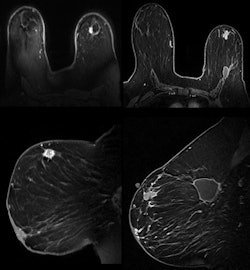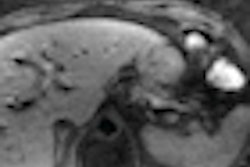
Accelerated partial-breast irradiation (APBI) is proving to be an effective treatment for qualified patients with early-stage breast cancer, but precise placement of the balloon catheter is imperative. A case of local recurrence believed to be caused by a malpositioned catheter was recently presented in the Breast Journal.
The patient was 64 years old when diagnosed with a 13-mm ductal carcinoma in her left breast, according to lead author Dr. Stephanie Valente, from the University of Southern California, and colleagues. She underwent breast conservation surgery and a sentinel lymph node biopsy. At surgery, a cavity evaluation device was positioned in the lumpectomy cavity through a separate stab incision placed laterally on the breast. An ultrasound exam confirmed a 9-mm skin bridge. Final pathology showed negative sentinel lymph nodes and clean margins (> 8 mm) (Breast Journal, November/December 2012, Vol. 18:6, pp. 591-595).
 |
| Initial MRI images in 2007 (left column) show an enhancing mass in the left breast. MRI images from 2010 (right) show an enhancing mass in the left breast in the same position. A seroma cavity is also seen on the postoperative images. All images courtesy of the Breast Journal. |
Three years later, the patient developed a cancerous 2-cm mass in the same location. When biopsied, the mass was identified as an invasive ductal carcinoma with similar pathological features, suggesting a local recurrence, according to the authors. They believe that the catheter was inserted into the cavity evaluation device spacer tract, and the balloon was expanded in the tract prior to reaching the lumpectomy cavity. The persistent seroma was a toxicity caused by the malpositioning.
Valente and colleagues believe this is the first case published in peer-reviewed literature to document balloon malpositioning as the direct cause of local recurrence. "This case is presented to illustrate the importance of comparing CT radiation planning images, with treatment catheter in place, to the original diagnostic breast imaging studies to confirm proper catheter positioning ... prior to initiating radiotherapy," they wrote.



















